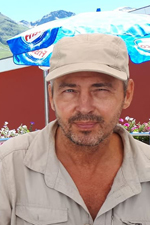 |
||
| Butterflies When asked "Why butterflies?" I really don't have a straightforward answer. And yes, as a child I already was chasing butterflies (and caterpillars), and over the years I took several pictures of butterflies on holidays, but only in 2002 I started to photograph butterflies in a more serious way. And to be honest the new fire started more or less by chance when I took some pictures of a common blue (anything but common) to try out my new digicam. Since then my fascination has been growing rapidly again. If anything, butterflies make me realise how fragile we really are: life is a miracle! Most of my pictures are made in Europe and Turkey. I included some pictures from trips to Oman, South Africa, Morocco and the United States (California). Identification can be difficult. I don't use a net, so identification is purely based on the pictures I managed to make. I am quite sure there will be errors on my website and welcome serious comments.
In 2002 I bought a macro lens (Sigma 180mm) which I mounted on my old analog Canon EOS 100. For a short period of time I worked with a Canon EOS 3, but soon I realised digital was the way to go. Over the years I had several digital Canons with an APC-sensor (1.6 crop factor), and in 2010 I switched to a full frame camera, first a Canon 5 mark !! and since 2017 a Canon 5 mark III. I still photograph with a Sigma 180mm, and I only had to use my backup lens once (Sigma 150mm, Italy/Switzerland 2019). Since 2004 I have used a tripod on almost all occasions (Gitzo Explorer G2220 or Explorer GT2531EX ). As mentioned before I use a tripod. In the beginning I had to get used to it, and occasionally I still miss an opportunity, but working with a tripod has some huge advantages. Firstly it is a good way to avoid camera shake, certainly combined with a remote control. Secondly it also enables you to focus manually. In live view (with a 10x magnification) you can focus very precisely on whatever spot you chose. In live view mirror shake is avoided as well. And lastly you are more in control of the composition My standard settings are F11 (comparable to F7 on a camera with an APC-sensor). ISO 200 and -2/3 underexposure. Above F11 the quality of an image deteriorates quickly. because of diffraction. In windy conditions I sometimes pick lower F-values to shorten the exposure time. I actually never tested at what ISO values noise starts to become problematic, but most of the time I use ISO 200 which delivers noise free images. I underexpose 2/3 stops to prevent overexposure of white fringes etc. In very bright light, or in case of high contrast I underexpose even more. The Gitzo Explorer is an extremely versatile tripod, and combined with the Sigma lens which has a tripod mount I am able to handle almost all situations. Only very active butterflies can be problematic, and that is one of the reasons I prefer to photograph early in the morning, or later in the afternoon when butterflies tend to be more easy going. Also sunny days with a casual rain shower are perfect for photographing butterflies. Certainly in the morning the light is more beautiful too. I photograph in natural light, and on rare occasions I use a reflector. In the past I always had a scissor with me, to get rid of disturbing grass or branches. But I use it less and less. And last but not least, I photograph the butterflies as I find them, so although highly fashionable, there are no staged pictures on my website. Stock photos In the past I have been represented by a stock agency. Sadly they are almost exclusively interested in staged pictures. Brightly lit flowery backgrounds with butterflies on colorful flowers. Often with butterflies that don't visit flowers, on flowers that are hardly ever visited by butterflies. I agree it makes beautiful pictures, but imho it has nothing to do with nature photography. I have lots of good pictures of almost 500 species, which are not shown on my website. So please contact me if you are interested. Website I started my website in 2005 with a trial-version of DreamWeaver. In those days there were no smartphones, so some pages don't perform very well on a smartphone. I always kept my website clean, so no advertising, unexpected pop ups or whatsoever.. However I am looking for a way to monetize my efforts and cover some of my costs. I decided to try out: Buy me a Coffee |
||
 |
||
| For any comments, answers or whatsoever you can send me an email at: peter@anythingbutcommon.nl |
||
 Gear
Gear